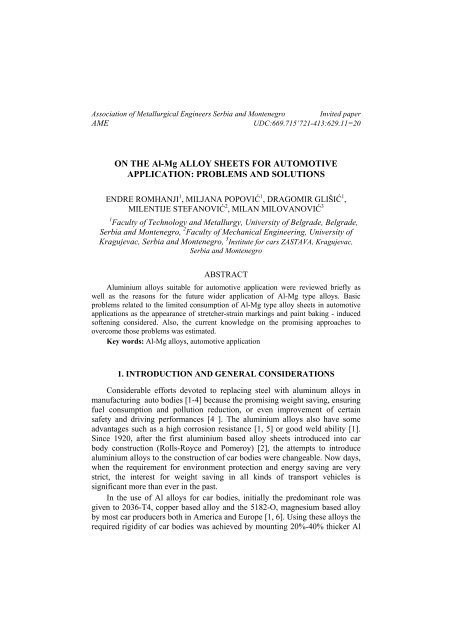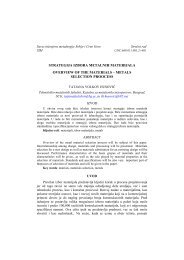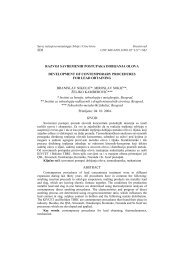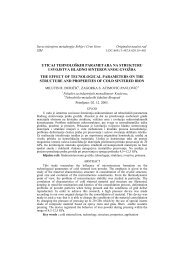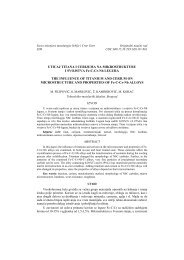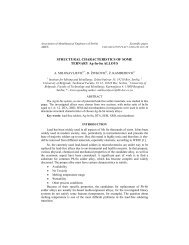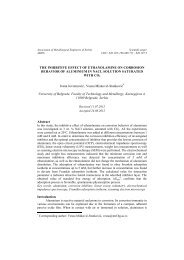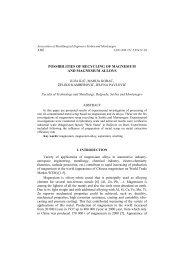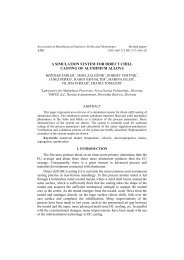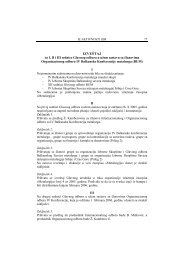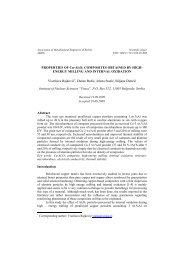ON THE Al-Mg ALLOY SHEETS FOR AUTOMOTIVE APPLICATION ...
ON THE Al-Mg ALLOY SHEETS FOR AUTOMOTIVE APPLICATION ...
ON THE Al-Mg ALLOY SHEETS FOR AUTOMOTIVE APPLICATION ...
You also want an ePaper? Increase the reach of your titles
YUMPU automatically turns print PDFs into web optimized ePapers that Google loves.
Association of Metallurgical Engineers Serbia and Montenegro Invited paper<br />
AME<br />
UDC:669.715’721-413:629.11=20<br />
<strong>ON</strong> <strong>THE</strong> <strong>Al</strong>-<strong>Mg</strong> <strong>ALLOY</strong> <strong>SHEETS</strong> <strong>FOR</strong> <strong>AUTOMOTIVE</strong><br />
APPLICATI<strong>ON</strong>: PROBLEMS AND SOLUTI<strong>ON</strong>S<br />
ENDRE ROMHANJI 1 , MILJANA POPOVIĆ 1 , DRAGOMIR GLIŠIĆ 1 ,<br />
MILENTIJE STEFANOVIĆ 2 , MILAN MILOVANOVIĆ 3<br />
1 Faculty of Technology and Metallurgy, University of Belgrade, Belgrade,<br />
Serbia and Montenegro, 2 Faculty of Mechanical Engineering, University of<br />
Kragujevac, Serbia and Montenegro, 3 Institute for cars ZASTAVA, Kragujevac,<br />
Serbia and Montenegro<br />
ABSTRACT<br />
<strong>Al</strong>uminium alloys suitable for automotive application were reviewed briefly as<br />
well as the reasons for the future wider application of <strong>Al</strong>-<strong>Mg</strong> type alloys. Basic<br />
problems related to the limited consumption of <strong>Al</strong>-<strong>Mg</strong> type alloy sheets in automotive<br />
applications as the appearance of stretcher-strain markings and paint baking - induced<br />
softening considered. <strong>Al</strong>so, the current knowledge on the promising approaches to<br />
overcome those problems was estimated.<br />
Key words: <strong>Al</strong>-<strong>Mg</strong> alloys, automotive application<br />
1. INTRODUCTI<strong>ON</strong> AND GENERAL C<strong>ON</strong>SIDERATI<strong>ON</strong>S<br />
Considerable efforts devoted to replacing steel with aluminum alloys in<br />
manufacturing auto bodies [1-4] because the promising weight saving, ensuring<br />
fuel consumption and pollution reduction, or even improvement of certain<br />
safety and driving performances [4 ]. The aluminium alloys also have some<br />
advantages such as a high corrosion resistance [1, 5] or good weld ability [1].<br />
Since 1920, after the first aluminium based alloy sheets introduced into car<br />
body construction (Rolls-Royce and Pomeroy) [2], the attempts to introduce<br />
aluminium alloys to the construction of car bodies were changeable. Now days,<br />
when the requirement for environment protection and energy saving are very<br />
strict, the interest for weight saving in all kinds of transport vehicles is<br />
significant more than ever in the past.<br />
In the use of <strong>Al</strong> alloys for car bodies, initially the predominant role was<br />
given to 2036-T4, copper based alloy and the 5182-O, magnesium based alloy<br />
by most car producers both in America and Europe [1, 6]. Using these alloys the<br />
required rigidity of car bodies was achieved by mounting 20%-40% thicker <strong>Al</strong>
206<br />
MJoM<br />
METALURGIJA - JOURNAL OF METALLURGY<br />
sheets in respect to the usual mild steel sheets. The 2036 alloy is heat – treatable<br />
(hardenable by aging) and it was used for outer body parts, while 5182 sheets<br />
due to their particular surface relief developed during Lüdering (due dynamic<br />
strain aging) were rather suitable for inner body elements. The 5182 alloy is<br />
non-heat-treatable, and hardenable by the <strong>Mg</strong> solute as well as by deformation.<br />
The two alloys have a quite different response during curing the painted car<br />
bodies. So, during paint baking the 2036 alloy at around 180°C considerable<br />
strengthening effects can be achieved due the precipitation hardening. At the<br />
same conditions the strength of <strong>Al</strong>-<strong>Mg</strong> alloys in a similar extent decrease after a<br />
5-7% pre-deformation. Further, it was recognized that the combination of these<br />
two alloys is unfavorable as far as recycling is concerned, due to the relatively<br />
high copper content in 2036 alloy. Searching for the alloy more compatible in<br />
recycling with 5000 type, the <strong>Al</strong><strong>Mg</strong>Si alloys (6000-heat-tretable series) were<br />
chosen. The basic response of 5000 and 6000 alloy sheets in paint baking is<br />
shown in Fig.1. It is obvious that after annealing at 200°C/30' the heat-treatable<br />
6009 alloy considerably hardened (the precipitation sequence is quite<br />
complicating [7]), while the 5182 one in a similar extent softens. The most<br />
frequently used alloys today and their chemical compositions are listed in Table<br />
1. Summary of the main characteristics and applications for the aluminium<br />
alloys used in car body constructions are given in Table 2. Some recent<br />
analyses [8] shown up a recommendation that the further automotive application<br />
of aluminium should be focused to the development of low cost, non-heattreatable<br />
aluminium alloy body sheets. Namely, it was estimated that there is<br />
potential for at least 10% lower costs for the non-heat-treatable alloys compared<br />
to the heat-treatable types. Such a considerations make attractive the further<br />
research and improvement of the highly alloyed and high strength <strong>Al</strong>-<strong>Mg</strong><br />
sheets. So, the objective of this work is comprehensive consideration of the<br />
basic deformation behavior of <strong>Al</strong>-<strong>Mg</strong> alloy sheets, current applicability<br />
restrictions and possible solutions for overcoming them.<br />
Table 1. Compositions of some aluminium alloys used for automotive panel<br />
applications (wt.%) [9]<br />
<strong>Al</strong>loy Si Fe Cu Mn <strong>Mg</strong> Cr Zn Ti<br />
5182-O 0.20 0.35 0.15 0.2-0.5 4.0-5.0 0.10 0.25 0.10<br />
5754-O 0.40 0.40 0.10 0.50 2.6-3.6 0.3 0.2 0.15<br />
5030-T4 0.25 0.40 0.50 0.20 3.5-5.0 0.2 0.1 0.10<br />
2036-T4 0.50 0.50 2.2-3.0 0.1-0.4 0.3-0.6 0.10 0.25 0.15<br />
6009-T4 0.6-1.0 0.50 0.15-0.60 0.2-0.8 0.4-0.8 0.10 0.25 0.10<br />
6010-T4 0.8-1.2 0.50 0.15-0.60 0.2-0.8 0.6-1.0 0.10 0.25 0.1<br />
6016-T4<br />
(Ac-120)<br />
1.0-1.5 0.5 0.2 0.2 0.25-0.6 0.1 0.2 0.15
<strong>ON</strong> <strong>THE</strong> <strong>Al</strong>-<strong>Mg</strong> <strong>ALLOY</strong> <strong>SHEETS</strong> <strong>FOR</strong> <strong>AUTOMOTIVE</strong> APPLICATI<strong>ON</strong> … 207<br />
Table 2. <strong>Al</strong>uminium car body sheet alloys [10]<br />
<strong>Al</strong>-<strong>Mg</strong><br />
AA5xxx<br />
<strong>Al</strong>-<strong>Mg</strong>-Cu<br />
AA5xxx<br />
<strong>Al</strong>-<strong>Mg</strong>-Si<br />
AA6xxx<br />
<strong>Al</strong>loy Advantages Disadvantages Examples<br />
<strong>Al</strong>-<strong>Mg</strong>-Si-Cu<br />
AA6xxx<br />
<strong>Al</strong>-Cu-<strong>Mg</strong>-Si<br />
AA2xxx<br />
- high formability<br />
- good corrosion resistance<br />
- medium to high strength<br />
- as above but also<br />
additional age hardening<br />
- high formability<br />
- good corrosion resistance<br />
- strengthening by aging<br />
- as above but higher<br />
strength<br />
- high formability<br />
- strengthening by aging<br />
- Lüders lines, "A" and "B"<br />
- SCC sensitive after<br />
exposure to temp. ∼ 100°C<br />
- softening after annealing<br />
- as above, but only "B"<br />
Lüders lines<br />
- as above but<br />
decreased corrosion<br />
resistance<br />
- decreased corrosion<br />
resistance<br />
-<br />
AA5754, AA5182<br />
for inner body parts<br />
AA5030, AA5032<br />
for outer body parts<br />
in Japan<br />
AA6016, AA6022<br />
standard alloy for<br />
outer body parts<br />
AA6009, AA6111<br />
outer/inner body<br />
AA2008, AA2036<br />
only used in USA<br />
Fig. 1. Effect of stretching and aging (30' at 204°C) on yield<br />
strength of 5182-O and 6009-T4 alloy sheets [6].<br />
2. <strong>Al</strong>-<strong>Mg</strong> <strong>ALLOY</strong> <strong>SHEETS</strong> <strong>FOR</strong> <strong>AUTOMOTIVE</strong> APPLICATI<strong>ON</strong><br />
The <strong>Al</strong>-<strong>Mg</strong> alloys have a favorable formability, as due solution hardening<br />
they can achieve high strength and high strain hardening ability, which enable a<br />
stable behavior in the complex forming operation, reducing the further material<br />
flow in the locally strained regions [11,12]. Such behavior is improved in alloys<br />
with higher <strong>Mg</strong> content. Besides the favorable forming behavior, the present<br />
solute atoms can induce some harmful surface appearance of produced auto<br />
body parts.
208<br />
MJoM<br />
METALURGIJA - JOURNAL OF METALLURGY<br />
Surface appearance. In <strong>Al</strong>-<strong>Mg</strong> alloys the dislocation reactions with solute<br />
<strong>Mg</strong> atoms, i.e. the dynamic strain aging (DSA), is the main source of unstable<br />
plastic flow during the uniaxial tension test. This unstable flow in alloys with<br />
more than 2% magnesium [7] appeared as a yield point elongation, know as a<br />
Lüders elongation. This inhomogeneous deformation occurs within the first few<br />
percent of straining when the stress is constant. After that – at higher strains, the<br />
DSA is manifested as a discontinuous or serrated yielding. Flow curves for a<br />
highly alloyed <strong>Al</strong><strong>Mg</strong>6.5Mn alloy sheet, after different treatment and strain rates<br />
are shown in Fig.2. The Lüders elongation plateaus and serrations or<br />
discontinuous yielding ranges are very clear. Both Lüdering and serrated yielding<br />
during uniaxial stretching cause the appearance of specific surface relief known as<br />
"A" ("flamboyant") and "B" ("parallel bands") type surface markings, respectively.<br />
Those markings and the appropriate parts of the flow curves are sown in Fig.3. The<br />
"A" stretcher markings are the most harmful as the appropriate roughness valleys<br />
developed within the first percent of straining can be more than 100 μm deep [14].<br />
The roughness created by "B" marking never exceeds 10 μm [15]. So, the "A" type<br />
stretcher markings are the main problem which reduces the application of a higher<br />
strength (highly alloyed) <strong>Al</strong>-<strong>Mg</strong> sheets only to the production of inner panels in car<br />
bodies<br />
Fig. 2. Load extension curves for the <strong>Al</strong><strong>Mg</strong>6.5Mn sheets at different<br />
strain rates and working conditions. [13]<br />
During biaxial stretching the surface appearance seems to change<br />
dependently on the degree of biaxiality. Namely, after stretching blanks of<br />
different widths across the hemispherical punch in a hydraulic press a net of<br />
parallel bands can be seen at the surface of the nearly uniaxially stretched<br />
samples which are “B” type (Fig. 4.a) without any traces of “A” type. The<br />
surface banding completely disappeared in the case of equibiaxially stretched<br />
sample (Fig.4.b). It is important to note that in the samples even nearly<br />
uniaxially stretched over the punch, the very harmful “A” type (“flamboyant”<br />
type) surface markings could not be observed. The latest result (Fig.4) indicates
<strong>ON</strong> <strong>THE</strong> <strong>Al</strong>-<strong>Mg</strong> <strong>ALLOY</strong> <strong>SHEETS</strong> <strong>FOR</strong> <strong>AUTOMOTIVE</strong> APPLICATI<strong>ON</strong> … 209<br />
that the surface appearance can be influenced in a great deal by changing the<br />
stress state, and that the harmful stretcher lines disappear in equibiaxial<br />
stretching. At this stage of the knowledge it is not clear how the stress state<br />
influence the DSA, inhibiting the appearance of the surface relief development<br />
under equibiaxial stretching. The meaning of the considered surface relief<br />
effects are clearly shown in Fig.5 at the photographs of real fender produced<br />
from <strong>Al</strong><strong>Mg</strong>4.5Mn0, 5 sheets, for the "ZASTAVA" car. The stretcher-strain lines<br />
developed are not uniform over the whole fender, but it seems dependent on the<br />
imposed stress state (the biaxiality varying over the fender during the pressing<br />
operation).<br />
Fig. 3. Uniaxial stress-strain curves with Lüders elongation<br />
(a) or only with serrated yielding straining range<br />
(b) and the sketches of appropriate surface markings.<br />
a) b)<br />
Fig. 4. Photographs and sketches for the samples stretched over<br />
hemispherical punch in near uniaxial (a) and equibiaxial tension (b) [16].
210<br />
MJoM<br />
METALURGIJA - JOURNAL OF METALLURGY<br />
Considering the problem how to suppress the Lüders elongation it is worth<br />
of note that applying some specific thermo-mechanical treatments as a<br />
combination of low cold rolling reductions and annealing (Fig.2), the Lüders<br />
elongation was completely suppressed. The grain size distributions for the<br />
applied working conditions are given in Table 3.<br />
x7 x 15<br />
Fig. 5. Photographs of the surface appearance at the fender made<br />
of AA5182 alloy sheet. [17]<br />
Table 3. Average grain diameters after different reductions and annealing at<br />
320°C/3h. [13]<br />
r (%) d av (μm) r (%) d av (μm)<br />
0 30.9 30 30.4<br />
5 35.1 40 23.2<br />
10 38.4 50 21.8<br />
15 40.5 60 20.6<br />
20 35.4 70 16.1<br />
Micrographs revealing the structures for the samples with no yield point<br />
elongation – after 10% deformation and with pronounced yield point elongation<br />
after 60% deformation are shown in Fig.6. The grain structure after 10%<br />
imposed reduction and annealing (Fig.6a), is a result of additional grain growth<br />
in the basic structure retained from the as received-annealed condition. <strong>Al</strong>so<br />
subgrains were generated by such a low deformation (Fig.6b). Besides the<br />
additional hardening brought by the presence of 1.0-1.5 μm sized subgrains [13]<br />
it was assumed that the higher dislocation density with weaker solute drag, as<br />
the <strong>Mg</strong> atmospheres become more dilute, is the main reason for vanishing the<br />
yield point elongation. It should be emphasized that grain sizes after those low<br />
reductions and annealing where ranged to 35÷40μm (Table 3), what is rather<br />
close to the grain sizes found in AA5754 alloy with <strong>Mg</strong>=2.6 - 3.6% when the<br />
Lüdering was suppressed [6]. On the other hand it is considerably finer than it<br />
was found for the AA5182 alloy with <strong>Mg</strong>=4 - 5%, when zero Lüders<br />
elongation was experienced after attaining the average grain diameter above<br />
100μm [11]. Such a behavior is rather clear if it is taken into account that the<br />
Lüders elongation increases by increasing the <strong>Mg</strong> content [11]. This result, in
<strong>ON</strong> <strong>THE</strong> <strong>Al</strong>-<strong>Mg</strong> <strong>ALLOY</strong> <strong>SHEETS</strong> <strong>FOR</strong> <strong>AUTOMOTIVE</strong> APPLICATI<strong>ON</strong> … 211<br />
respect to some other considerations [18] that the free slip distance during<br />
Lüdering is equal to the grain size, lead to the assumption that the subgrains<br />
doesn't restrict the free slip distance.<br />
The general rule of the grain size effect on the appearance of the yield point<br />
elongation was established many years ago, estimating that at grain sizes above 50μm<br />
the Lüders lines are eliminated or enough suppressed [19]. This result unfortunately<br />
didn't bring a final solution, as a coarse grained structure is mostly unacceptable due the<br />
lover strength, lower biaxial ductility with the pronounced surface roughness. <strong>Al</strong>so, in<br />
some cases is unacceptable the technologically demanding procedure to achieve such a<br />
range of coarse grains. Namely, the grain growth is inhibited in the presence of<br />
dispersoids formed in homogenization or hot rolling [12], specially in the presence of<br />
Mn bearing particles (<strong>Al</strong> 6 Mn) [20] which are typical for most of <strong>Al</strong>-<strong>Mg</strong> type alloys.<br />
Figs.6a to d. Optical micrographs of grain structure for samples deformed 10%<br />
(a) and 60% (c), and annealed at 320 o C/3h, and TEM micrographs of the<br />
corresponding dislocation substructures showing: subgrains (b) and randomly<br />
distributed dislocations (d), respectively.[13]<br />
Having in mind the basic demand to control the DSA, it was assumed that<br />
altering the temperature and strain rate in shaping operation is a good approach<br />
for prevention surface relief formation [21]. In other words serrated yielding<br />
occurs only within specific strain rate and temperature ranges. In Fig. 7. the<br />
regions marked C, A+B, and A are regions where different types of serrated<br />
yielding occur on the stress - strain curve. The regions marked zero are where<br />
no serrated yielding or Lüdering occur. This figure shows that at higher
212<br />
MJoM<br />
METALURGIJA - JOURNAL OF METALLURGY<br />
temperatures, higher strain rates can be achieved in the forming operations<br />
without formation Lüders bands.<br />
Fig. 7. Temperature and strain rate dependence of serrated yielding<br />
which results in Lüders band formation [21].<br />
Softening. Important point in making car bodies is the paint baking<br />
sequence inducing softening of the parts made by <strong>Al</strong>-<strong>Mg</strong> sheets, what is the<br />
second unfavorable property for their automotive application. The softening<br />
effects are well documented [7, 11]. Fig.8 shows the softening responses in the<br />
AA5182 sheets. As was already mentioned the heat-treatable alloys were<br />
chosen because of their ability to overcome this problem by precipitation at<br />
baking temperatures, which are ranged to 160°-180°C, usually in 30'. However,<br />
due to introducing some new materials in car bodies and reasons of environment<br />
protection, when water-based automobile paints are expected to be introduced,<br />
the baking temperatures seems to be shifted to the range of lower temperatures<br />
as 140°C-170°C [22, 23]. On the other hand those temperatures appeared to be<br />
not sufficient for effective precipitation hardening of AA6000 type alloys.<br />
Fig. 8. Aging time influence on the yield stress decrease<br />
(softening) in AA5182 sheets [7].<br />
The current efforts to overcome the softening problems in <strong>Al</strong>-<strong>Mg</strong> alloys<br />
resulted with the idea of adding a small amount of copper to the <strong>Al</strong>-<strong>Mg</strong> alloys,
<strong>ON</strong> <strong>THE</strong> <strong>Al</strong>-<strong>Mg</strong> <strong>ALLOY</strong> <strong>SHEETS</strong> <strong>FOR</strong> <strong>AUTOMOTIVE</strong> APPLICATI<strong>ON</strong> … 213<br />
i.e. the development of <strong>Al</strong>-<strong>Mg</strong>-Cu type alloy, which could additionally harden<br />
by precipitation during paint-baking [24-29]. This alloy has a low Cu/<strong>Mg</strong> ratio:<br />
0.14-0.29 in wt%. Basically the AA5182 alloy was additionally alloyed with<br />
0.5% Cu, appearing as new alloy designated as AA5030 (the chemical<br />
composition is given in Table 1.). Such alloy should be pertinent for solution of<br />
both the necessary hardening effects at reduced baking temperatures and<br />
prevention of the softening effect typical for the classical <strong>Al</strong>-<strong>Mg</strong> alloys.<br />
The mechanical properties for the most often used <strong>Al</strong> alloys are given in<br />
Table 4. It should be noted that two 5030 alloys presented, first is the original<br />
Kobe produced one [9] and the second - experimental one developed and<br />
produced by IMPOL-SEVAL Rolling Mill in cooperation with the Faculty of<br />
Technology and Metallurgy of the Belgrade University. In table 4. the bake<br />
hardening is also shown up by listing the yield stress values after simulating<br />
baking conditions. In the case of IMPOL-SEVAL type 5030 alloy sheet the<br />
range of yield stresses and elongations are given, which have been achieved by<br />
applying a different thermo-mechanical treatments.<br />
Table 4. Mechanical properties of some aluminium alloys used for automotive<br />
panel applications, including [9]<br />
<strong>Al</strong>loy<br />
R p02<br />
[MPa]<br />
R p02 *<br />
[MPa]<br />
R m<br />
[MPa]<br />
e t<br />
[%]<br />
2036-T4 185 179 338 24<br />
6009-T4 131 234 220 25<br />
6010-T4 186 255 290 24<br />
6016-T4 (Ac-120) 137 220 248 29<br />
5182-O 130 - 276 26<br />
5030-T4<br />
Kobe<br />
138 172 276 30<br />
5030-T4**<br />
Impol-Seval<br />
R p02 * - yield stress after paint baking<br />
** Under development and current laboratory testing<br />
125-140 155-170 280-287 21-26<br />
Stress corrosion cracking (SSC) susceptibility. The <strong>Al</strong>-<strong>Mg</strong> alloys containing<br />
more than 3% <strong>Mg</strong> become susceptible to SSC due the supersaturation of<br />
solid solution and increased tendency of <strong>Mg</strong> atoms to precipitate at grain<br />
boundaries as a highly anodic β-phase (<strong>Mg</strong> 5 <strong>Al</strong> 8 ) [30-33]. The influence of the<br />
thermomechanical treatment on the SSC properties in <strong>Al</strong><strong>Mg</strong>6.8 type alloy,<br />
estimated by the elongation loss (El loss =1-(El SCC / El air )x100%) in slow strain rate<br />
tension test in corrosive environment, is shown in Fig.9 [34]. The tested<br />
specimens were sensitized for 7 days at 100°C after the applied treatments. It is
214<br />
MJoM<br />
METALURGIJA - JOURNAL OF METALLURGY<br />
apparent that the low temeprature annealing is beneficial in respect the SSC,<br />
when discontinuous β-phase precipitates were experienced in a globular form<br />
throughout the grain structure [34]. In the deformed and fully annealed<br />
structures the β-phase was found precipitated along the planes of localized<br />
deformation and grain boundaries, respectively.<br />
100<br />
1<br />
2<br />
3<br />
80<br />
El loss<br />
, %<br />
60<br />
40<br />
20<br />
0<br />
as-cold rolled<br />
3h 30min<br />
6h 10min<br />
12h<br />
0 200 250 300 350 400 450 500<br />
temperature, 0 C<br />
Fig. 9. The elongation percentage loss, El loss , for the various<br />
specimens after sensitization. [34]<br />
C<strong>ON</strong>CLUSI<strong>ON</strong>S<br />
The <strong>Al</strong>-<strong>Mg</strong> type alloy sheets are cost-effective very promising material for<br />
automotive application. The most important obstacles for their wider<br />
applications are related to the bed surface appearance developing during the<br />
forming operations and to the softening effect coming into play in the paint<br />
baking sequence of car bodies.<br />
The harmful surface appearance is closely related to dynamic strain aging<br />
(DSA) due the reactions of <strong>Mg</strong> atoms with mobile dislocations. So, the solution<br />
for suppressing the DSA is firstly defined as a particular temperature – strain<br />
rate conditions necessary for performing the forming operation when the<br />
serrated yielding vanishing. For avoiding the harmful "A" type stretcher strain<br />
markings (developing during the yield point elongation), the coarse grain size<br />
was found beneficial. This effect is limited, as the coarse grains can cause other<br />
problems in the forming operations. The specific – low reduction treatment of<br />
the annealed sheet material (characterized with higher density of mobile<br />
dislocations) seems to be promising in suppressing the yield point elongation.<br />
Finally, it was also noticed that the surface banding is stress state dependent and<br />
that it can disappear in equibiaxial stretching.<br />
The softening effect as a natural consequence of the recovery process in the<br />
deformed parts during paint baking was prevented introducing a little amount of<br />
copper, which can produce an additional hardening effect compensating the<br />
mentioned recovery induced softening.
<strong>ON</strong> <strong>THE</strong> <strong>Al</strong>-<strong>Mg</strong> <strong>ALLOY</strong> <strong>SHEETS</strong> <strong>FOR</strong> <strong>AUTOMOTIVE</strong> APPLICATI<strong>ON</strong> … 215<br />
Both solutions for eliminating the surface relief are of limited meaning as<br />
their implementation is rather complicate for routine industrial practice. The<br />
new 5030 type alloy is the promising solution for overcoming both the<br />
undesired surface appearance as well as the softening problems.<br />
The susceptibility to the appearance of SCC appeared to be completely<br />
suppressed after low temperature annealing.<br />
Acknowledgement: The authors are grateful to the Ministry of Science and<br />
Technology of the Republic of Serbia and to the Impol-Seval <strong>Al</strong>uminium Mill<br />
for the financial support and for supplying the material used in this project.<br />
REFERENCES<br />
[1] G.S. Hsu, D.S. Thompson, Sheet Metal Industries, 51 (1974) 772.<br />
[2] P. Furrer, P.M.B. Rodrigues, in Proceedings of the IV Int.Symp.on the Plasticity and<br />
Resistance to Metal Deformation, (Herceg-Novi, Yugoslavia, 26-28 April, 1984)<br />
p.357.<br />
[3] P.M.B. Rodrigues, Sheet Metal Industries, 61 (1984) 492.<br />
[4] Anon., "Automotive Application of <strong>Al</strong>uminium", the <strong>Al</strong>uminium Association-Auto &<br />
Light Truck Group, 2002.<br />
[5] T.J. Summerson, D.O. Sprowls, in Proceedings of <strong>Al</strong>uminium <strong>Al</strong>loys-Their Physical<br />
and Mechanical Properties, vol.III, ed. by E.A Starke Jr. and T.H. Sanders Jr.,<br />
(Charlottesville, Virginia, USA, 15-20 June, 1986) p.1575.<br />
[6] W.C. Weltman, Sheet Metal Ind., No9, 60 (1983) 497.<br />
[7] G.B. Buger, A.K. Gupta, P.W. Jeffrey, D.J. Lloyd, Mater. Characterization,<br />
35(1995)23.<br />
[8] S.K. Das, H.W. Hayden, G.B. Barthold, Materials Science Forum – Trans Tech Publ.,<br />
Switzerland, 331-337 (2000) 913.<br />
[9] J.M. Story, G.W. Jarvis, H.R. Zonker, S.J. Murtha, SAE Paper No 930277, (1993)<br />
320.<br />
[10] P. Furrer, Conf.Proc.:"<strong>Al</strong>uminium97", 24-25 Sept. 1997, Essen, Germany, p.10/1.<br />
[11] J. Hirsch, Materials Science Forum-Trans Tech Publications, Switzerland,<br />
242(1997)33.<br />
[12] P.V. Czarnowski, J. Hirsch, in Conf. Proc ″<strong>Al</strong>uminium 97″, 24-25 September 1997,<br />
Essen, Germany, p.11/1.<br />
[13] E. Romhanji, M. Popović, V. Radmilović, Z. Metallkd., No4, 90 (1999) 305.<br />
[14] E. Pink, A. Grinberg, ALUMINIUM, 60 (1984) E601.<br />
[15] R. Chadwick, W.H.L. Hooper, J. Inst. Met., 80 (1951/52)17.<br />
[16] E. Romhanji, D. Glišić, V. Milenković, Mater. Techn., No1-2, 35 (2001) 21.<br />
[17] M. Milovanović, M. Stefanović, E. Romhanji, Unpublished work, 2002.<br />
[18] D.J. Lloyd, L.R. Morris, Acta metall, 25 (1977) 857.
216<br />
MJoM<br />
METALURGIJA - JOURNAL OF METALLURGY<br />
[19] V.A. Phillips, A.J. Swain, R. Eborall, J. Inst. Metals, 81(1952-1953) 626.<br />
[20] H. Watanabe, K. Ohori, Y. Takeuchi, Trans., ISIJ, 27 (1987) 730.<br />
[21] J.M. Robinson, M.P. Shaw, Int. Mater. R., 39 (1994) 113.<br />
[22] P. Racthev, B. Verlinden, P. De Smet, P. Van Houte, Materials Trans., JIM, No1,<br />
40 (1999) 34.<br />
[23] K.R. Brown, M.S. Venie, R.A. Woods, JOM, 47 (1995) 20.<br />
[24] T. Fujita, K. Hasegawa, M. Suga: European Patent no.0616044 A2, (1994).<br />
[25] Y. Suzuki, M. Matsuo, M. Saga, M. Kikuchi, in Proc. 5th Int. Conf. On <strong>Al</strong> <strong>Al</strong>loys,<br />
Grenoble, Material Science Forum, 217-222 (1996) 1789.<br />
[26] P. Racthev, B. Verlinden, P. De Smet, P. Van Houte, Materials Trans., JIM, No1,<br />
40 (1999) 34.<br />
[27] P. Racthev, B. Verlinden, P. De Smet, P. Van Houte, Acta mater., No10, 46 (1998)<br />
3523.<br />
[28] P. Racthev, B. Verlinden, P. De Smet, P. Van Houte, in Proc of ICAA-6:<br />
<strong>Al</strong>uminium <strong>Al</strong>loys, vol.2, 1998, p.757.<br />
[29] B.Verlinden, P. Racthev, P. De Smet, P. Van Houte, in Proc of ICAA-6:<br />
<strong>Al</strong>uminium <strong>Al</strong>loys, vol.2, 1998, p.1075.<br />
[30] J.R. Davies, Corrosion of <strong>Al</strong>uminum and <strong>Al</strong>uminum <strong>Al</strong>loys, ASM Intl., Materials<br />
Park, OH, 1999.<br />
[31] T.J. Summerson, D.O. Sprowls, <strong>Al</strong>uminum <strong>Al</strong>loys – Their Physical and<br />
Mechanical Properties, Charlottesville, Virginia, USA, vol.III (1986) 1576.<br />
[32] E.C.W. Perryman, G.B. Brook, J. Inst. Metals, 79 (1951) 19.<br />
[33] D. Sampath, et.al., Mater. Sci. Forum, 331-337 (2000) 1089.<br />
[34] M. Popović, E. Romhanji, J. Mat. Proc. Techn., 125/126 (2002) 275.


